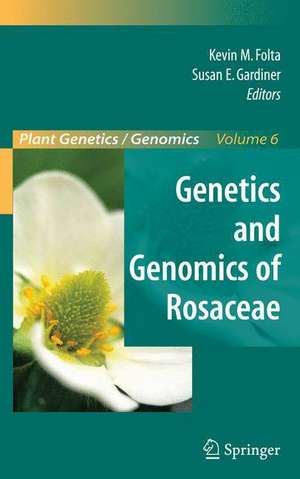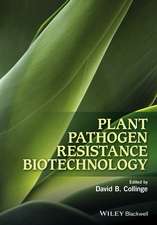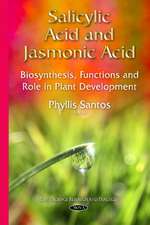Genetics and Genomics of Rosaceae: Plant Genetics and Genomics: Crops and Models, cartea 6
Editat de Kevin M. Folta, Susan E. Gardineren Limba Engleză Hardback – 7 mai 2009
| Toate formatele și edițiile | Preț | Express |
|---|---|---|
| Paperback (1) | 2104.98 lei 6-8 săpt. | |
| Springer – 20 sep 2014 | 2104.98 lei 6-8 săpt. | |
| Hardback (1) | 2116.19 lei 6-8 săpt. | |
| Springer – 7 mai 2009 | 2116.19 lei 6-8 săpt. |
Din seria Plant Genetics and Genomics: Crops and Models
- 18%
 Preț: 967.40 lei
Preț: 967.40 lei - 18%
 Preț: 1240.47 lei
Preț: 1240.47 lei - 18%
 Preț: 1235.88 lei
Preț: 1235.88 lei - 18%
 Preț: 956.33 lei
Preț: 956.33 lei - 18%
 Preț: 1233.06 lei
Preț: 1233.06 lei - 18%
 Preț: 955.08 lei
Preț: 955.08 lei - 18%
 Preț: 1228.29 lei
Preț: 1228.29 lei - 18%
 Preț: 1121.13 lei
Preț: 1121.13 lei - 18%
 Preț: 1009.54 lei
Preț: 1009.54 lei - 20%
 Preț: 574.08 lei
Preț: 574.08 lei - 18%
 Preț: 943.73 lei
Preț: 943.73 lei - 18%
 Preț: 948.92 lei
Preț: 948.92 lei - 18%
 Preț: 1234.14 lei
Preț: 1234.14 lei - 18%
 Preț: 1221.69 lei
Preț: 1221.69 lei - 18%
 Preț: 1235.43 lei
Preț: 1235.43 lei - 9%
 Preț: 1007.69 lei
Preț: 1007.69 lei
Preț: 2116.19 lei
Preț vechi: 2580.72 lei
-18% Nou
Puncte Express: 3174
Preț estimativ în valută:
404.99€ • 421.25$ • 334.34£
404.99€ • 421.25$ • 334.34£
Carte tipărită la comandă
Livrare economică 14-28 aprilie
Preluare comenzi: 021 569.72.76
Specificații
ISBN-13: 9780387774909
ISBN-10: 0387774904
Pagini: 636
Ilustrații: XVII, 636 p.
Dimensiuni: 155 x 235 x 30 mm
Greutate: 1.23 kg
Ediția:2009
Editura: Springer
Colecția Springer
Seria Plant Genetics and Genomics: Crops and Models
Locul publicării:New York, NY, United States
ISBN-10: 0387774904
Pagini: 636
Ilustrații: XVII, 636 p.
Dimensiuni: 155 x 235 x 30 mm
Greutate: 1.23 kg
Ediția:2009
Editura: Springer
Colecția Springer
Seria Plant Genetics and Genomics: Crops and Models
Locul publicării:New York, NY, United States
Public țintă
ResearchCuprins
Rosaceae: Taxonomy, Economic Importance, Genomics.- Rosaceae: Taxonomy, Economic Importance, Genomics.- Genomics Approaches to Crop Improvement in the Rosaceae.- Genomics Opportunities, New Crops and New Products.- Apples: (Chapters 4 – 7).- to Apple (Malus × domestica).- Apple Structural Genomics.- Apple Functional Genomics.- Apple Transformation and Translational Genomics.- Pear Genomic.- Pear Genomics.- Genomics of Almond.- Peach (Chapters 10 – 13).- An Introduction to Peach (Prunus persica).- Peach Structural Genomics.- Functional Genomics in Peach.- Genetic Engineering of Plum (Prunus domestica L.) for Plant Improvement and Genomics Research in Rosaceae.- Sweet and Sour Cherries: Linkage Maps, QTL Detection and Marker Assisted Selection.- Sweet and Sour Cherries: Linkage Maps, QTL Detection and Marker Assisted Selection.- Genomics-Based Opportunities in Apricot.- Rose (Chapters 16 – 19).- to Rosa.- Rose Structural Genomics.- Functional Genomics in Rose.- Genetic Engineering and Tissue Culture of Roses.- Strawberry (Chapters 20 – 23).- Strawberry Genomics: Botanical History, Cultivation, Traditional Breeding, and New Technologies.- Strawberry (Fragaria spp.) Structural Genomics.- Functional Molecular Biology Research in Fragaria.- GMO Strawberry: Methods, Risk and Benefits.- Raspberries and Blackberries: The Genomics of Rubus.- Raspberries and Blackberries: The Genomics of Rubus.- Loquat (Eriobotrya Lindl.).- Genomics Tools Across Rosaceae Species.- Application of Genetic Markers in Rosaceous Crops.- Rosaceaous Genome Sequencing: Perspectives and Progress.
Textul de pe ultima copertă
Genomics of the Rosaceae
Edited by Kevin M. Folta and Susan E. Gardiner
Plant Genetics and Genomics: Crops and Models book series provides current overviews and summaries of the state of the art in genetics and genomics for each of the important crop plants and genetic models for which such a volume does not now exist or is out of date. Volumes will focus on a single crop, species, or group of close relatives, including especially those plants that already have advanced genomic resources developed and preferably complete or advancing genome sequences.
The Rosaceae Family includes many significant fruit, nut, ornamental and wood crops. Traditionally their large stature, long juvenility periods, and often complicated genomes presented little opportunity for genetic or genomic inquiry. But the new millennium brings with it new challenges to production of the highly desirable products from this family, challenges that genetic and genomic tools may help resolve. Together necessity and scientific curiosity conspire to launch deep exploration of rosaceous crop biology. This volume originates at an acceleration point for Roscaeae genomics. A foundation of outstanding tools has been developed in a cross-section of species. The successes and failures of various approaches have been documented from model systems and inform our attack on questions within the valued crops within the Rosaceae. The text within describes the species and products of this plant family along with a synopsis of the current state of research presented from experts active on the front line of Rosaceae genomics research.
Kevin M. Folta is a native of Chicago, Illinois USA. Kevin completed his Ph.D. work in identification of blue light regulated promoter elements and post-transcriptional light-regulated mRNA stability at the University of Illinois at Chicago. Postdoctoral work at the University of Wisconsin centered on light regulated electrophysiology, gene expression and high-resolution growth monitoring. Kevin has maintained a unique research program in photomorphogenesis and a separate emphasis in strawberry genomics at the University of Florida in Gainesville, FL. He is active in public science education and has won awards for dedication to undergraduate research.
Susan E. Gardiner grew up on a sheep farm in Christchurch, New Zealand. Home schooled as a child, Sue later obtained both her undergraduate degree and PhD in Biochemistry from Otago University in Dunedin, New Zealand. Her post-doctoral period was spent in Freiburg, Germany, where she worked to elucidate the mechanism of differential regulation of the enzymes of phenylpropanoid biosynthesis in a parsley cell culture system irradiated with UV light. In 1980, Sue joined the Plant Physiology Division of the Department of Scientific and Industrial Research (DSIR) in Palmerston North, New Zealand where she first worked on the elucidation of chloroplast glycerolipid biosynthesis and later developed techniques for distinguishing varieties of pasture grasses and legumes. Sue’s work on gene mapping in apple began in 1990 at DSIR and continued when DSIR was restructured into HortResearch in 1992. Today, Sue leads a team working to unravel the genetic architecture of traits of fruit crops central to New Zealand fruit industries. Technological advancements in Genomics at HortResearch proved to be critical in her success in identification of ‘breeder-friendly markers for traits of economic value.’ Sue has developed an extensive network of international collaborators in Rosaceae genomics, and recently completed a 2-year term as Chair of the International Rosaceae Genomics Initiative. Sue derives her greatest satisfaction from seeing her team’s marker technologies being used by breeders.
Edited by Kevin M. Folta and Susan E. Gardiner
Plant Genetics and Genomics: Crops and Models book series provides current overviews and summaries of the state of the art in genetics and genomics for each of the important crop plants and genetic models for which such a volume does not now exist or is out of date. Volumes will focus on a single crop, species, or group of close relatives, including especially those plants that already have advanced genomic resources developed and preferably complete or advancing genome sequences.
The Rosaceae Family includes many significant fruit, nut, ornamental and wood crops. Traditionally their large stature, long juvenility periods, and often complicated genomes presented little opportunity for genetic or genomic inquiry. But the new millennium brings with it new challenges to production of the highly desirable products from this family, challenges that genetic and genomic tools may help resolve. Together necessity and scientific curiosity conspire to launch deep exploration of rosaceous crop biology. This volume originates at an acceleration point for Roscaeae genomics. A foundation of outstanding tools has been developed in a cross-section of species. The successes and failures of various approaches have been documented from model systems and inform our attack on questions within the valued crops within the Rosaceae. The text within describes the species and products of this plant family along with a synopsis of the current state of research presented from experts active on the front line of Rosaceae genomics research.
Kevin M. Folta is a native of Chicago, Illinois USA. Kevin completed his Ph.D. work in identification of blue light regulated promoter elements and post-transcriptional light-regulated mRNA stability at the University of Illinois at Chicago. Postdoctoral work at the University of Wisconsin centered on light regulated electrophysiology, gene expression and high-resolution growth monitoring. Kevin has maintained a unique research program in photomorphogenesis and a separate emphasis in strawberry genomics at the University of Florida in Gainesville, FL. He is active in public science education and has won awards for dedication to undergraduate research.
Susan E. Gardiner grew up on a sheep farm in Christchurch, New Zealand. Home schooled as a child, Sue later obtained both her undergraduate degree and PhD in Biochemistry from Otago University in Dunedin, New Zealand. Her post-doctoral period was spent in Freiburg, Germany, where she worked to elucidate the mechanism of differential regulation of the enzymes of phenylpropanoid biosynthesis in a parsley cell culture system irradiated with UV light. In 1980, Sue joined the Plant Physiology Division of the Department of Scientific and Industrial Research (DSIR) in Palmerston North, New Zealand where she first worked on the elucidation of chloroplast glycerolipid biosynthesis and later developed techniques for distinguishing varieties of pasture grasses and legumes. Sue’s work on gene mapping in apple began in 1990 at DSIR and continued when DSIR was restructured into HortResearch in 1992. Today, Sue leads a team working to unravel the genetic architecture of traits of fruit crops central to New Zealand fruit industries. Technological advancements in Genomics at HortResearch proved to be critical in her success in identification of ‘breeder-friendly markers for traits of economic value.’ Sue has developed an extensive network of international collaborators in Rosaceae genomics, and recently completed a 2-year term as Chair of the International Rosaceae Genomics Initiative. Sue derives her greatest satisfaction from seeing her team’s marker technologies being used by breeders.
Caracteristici
The first book on Rosaceae genomics Discusses recent developments in the field Presents application of genomics technologies for crop development Includes supplementary material: sn.pub/extras






